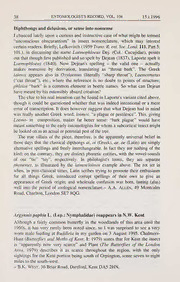
Diphthongs and delusions, or sense into nonsense PDF
Preview Diphthongs and delusions, or sense into nonsense
38 ENTOMOLOGIST'S RECORD, VOL. 108 15.1.1996 Diphthongs and delusions, or sense into nonsense I chanced lately upon a curious and instructive case ofwhat might be termed "unconscious obscurantism" in insect nomenclature, which may interest certain readers. Briefly, Lefkovitch (1959 Trans. R. ent. Soc. Lond. Ill, Part 5: 101.), in discussing the name Laemophloeus Dej. (Col.: Cucujidae), points out that though first published and so spelt by Dejean (1837), Laporte spelt it Loemophloeus (1840). Now Dejean's spelling - the valid one - actually makes nonsense by derivation, translating as "throat bark". The Greek laimos appears also in Oxylaemus (literally "sharp throat"), Laemotmetus ("cut throat"), etc., where the reference is no doubt to points of structure; phloios "bark" is a common element in beetle names. So what can Dejean have meant by his ostensibly absurd creation? The clue to his real intention can be found in Laporte's variant cited above, though it could be questioned whether that was indeed intentional or a mere error oftranscription. It does however suggest that what Dejean had in mind was really another Greek word, loimos, "a plague or pestilence". This, giving Loemo- in composition, makes far better sense: "bark plague" would have meant something to the early entomologists for whom a subcortical insect might be looked on as an actual or potential pest ofthe tree. The true villain of the piece, therefore, is the apparently universal belief in those days that the classical dipthongs ai, oi (Greek), ae, oe (Latin) are simply alternative spellings and freely interchangeable. In fact they are nothing of the kind; on the contrary, they are distinct phonetic entities, with the vowel-sounds of our "tie" "toy", respectively. In philologist's terms, they are separate phonemes, as illustrated by the laimoslloimos example above. The rot set in when, in post-classical times, Latin scribes trying to promote their enthusiasm for all things Greek, introduced corrupt spellings of their own to give an appearance of Greek origin; and wholesale confusion was bom, lasting (alas) well into the period of zoological nomenclature.- A.A. Allen, 49 Montcalm Road, Charlton, London SE7 8QG. Argynnispaphia L. (Lep.: Nymphalidae) reappears in N.W. Kent Although a fairly common butterfly in the woodlands of this area until the 1960s, it has very rarely been noted since, so I was surprised to see a very worn male feeding at Buddleia in my garden on 3 August 1995. Chalmers- Hunt {Butterflies and Moths ofKent, 1: 1979) states that for Kent the insect is "apparently now very scarce" and Plant (The Butterflies of the London Area, 1979) describes it as scarce throughout the region, with the only sightings for the Kent portion being south of Orpington, some seven to eight miles to the south-west. - B.K. West, 36 Briar Road, Dartford, Kent DA5 2HN.
